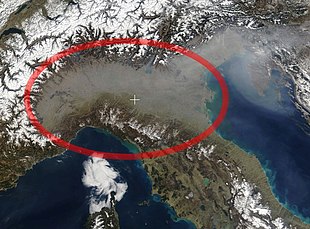Po plain
Coordinates: 45 ° 0 ′ N , 10 ° 0 ′ E
The Po Plain ( Pianura Padana in Italian ) is an extensive, fertile lowland in northern Italy , and with an area of 50,000 km² it represents the majority of the northern Italian (Upper Italian) lowland and the core area of northern Italy , but at Como it still extends somewhat into the Mendrisiotto , the southernmost district of Switzerland . It is named after the Po , the largest river in Italy.
Location and landscape
The northern Italian plain extends along the interior of the Alpine arc and north of the Apennines to the Upper Adriatic . The Po Plain stretches mainly from west to east and is around 400 km long in total. It measures between 70 and 200 km in width. In the north and west it is through the Alps and the hills of Monferrato limited to the south by the mountain ranges of the Apennines . To the east it opens and widens towards the Adriatic . The largest river today is the Po , which flows into the Upper Adriatic in a huge delta .
The Colli Berici and the Euganean Hills (it. Colli Euganei) lie between Verona , Vicenza and Padua . Some of these are of volcanic origin. They represent a certain natural division of the Northern Italian Plain into the Adriatic Eastern part and a subalpine western part, which is called the Po Plain in the broader sense, although the Veronese Plain (Bassa veronese) already lies on the Adige , which is no longer a tributary of the Po is, but goes directly to the Adriatic Sea. If one specifically means the Po catchment area , one speaks of Val padana ('Po valley', not common in German).
Politically, the Po Valley belongs to the Italian regions of Piedmont , Lombardy , Emilia-Romagna and Veneto and, to a small extent, to the Swiss canton of Ticino .
The plain was formed since the Tertiary as part of the alpine mountain formation through erosion and sedimentation of the alpine rivers into the upstream geological depression of the upper Adriatic, which was alternately mainland and shallow sea. This molasse trough is partly filled with sediment several thousand meters deep . Not all of the area is lowland in the narrower sense of the word; the Po reaches 100 meters above sea level at Casale west of Milan, but over half of the area is gently sloping .
View from the hills of Albinea, Reggio Emilia province
The Po plain at Borgomanero with the Valais Alps in the background
The Po plain near Jesolo near Venice
climate
The Po plain has always been one of the most fertile and populous regions in Italy. Sugar beets , corn , wheat and especially wine are the most commonly grown crops. Rice cultivation , which was still important 50 years ago, has declined sharply.
Climatically, the Po plain belongs to the warm-temperate climate zone, the transitional seasons are mostly warm and sunny, in summer the temperatures can rise to 38 ° C. However, the plain has relatively cool winters by Italian standards. Between November and February there are more frequent light frosts and periods of fog. The occurrence of Mediterranean vegetation is limited in large parts of the region. Often, Mediterranean plants alternate with those from the temperate latitudes of Central Europe. A large part of the natural tree population consists of deciduous trees. Mediterranean hardwood forests ( macchia ) and pine trees are only to be found south of the Po , there especially near the coast to the Adriatic Sea . However, Mediterranean or subtropical plant species such as various palm species are often used in garden design. As a result of the climate, instead of tropical fruits, potatoes, vegetables, rice, corn, tomatoes, melons and wheat are grown. The southern edge of the Alps and the northern Italian lakes form a special climatic feature . Due to the protection from north winds, the winter months are almost frost-free and relatively mild, so that Mediterranean vegetation can exist. In particular, citrus fruits thrive there, which are otherwise only very rarely found in northern to central Italy.
In the Po Valley, the air exchange is not given in all weather conditions, which is why the region is often polluted by smog .
Cities
The largest and most important cities in the Po Valley include:
in Piedmont:
in Lombardy:
in Veneto:
in Emilia-Romagna:
Web links
- Pina Springer: Podelta (accessed September 28, 2015)
- Walter Nelz: On the irrigation of the Po Valley (accessed on September 28, 2015)
- Berliner Zeitung: When the rice is ripe, the colors glow. (accessed on September 28, 2015)
Individual evidence
- ↑ Massive pollution - “Nowhere do so many fall ill from smog as in Northern Italy” . In: Swiss Radio and Television , January 10, 2020; accessed on February 10, 2020.



